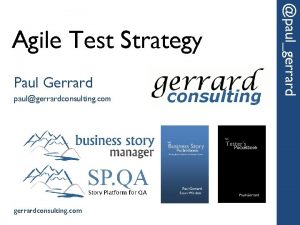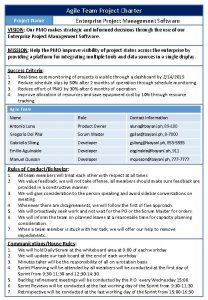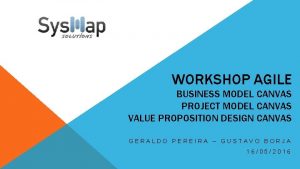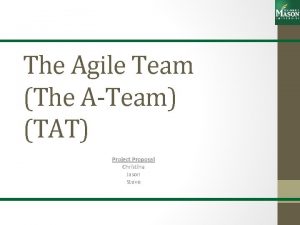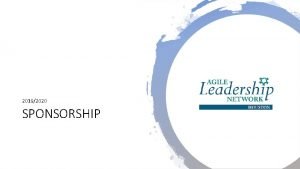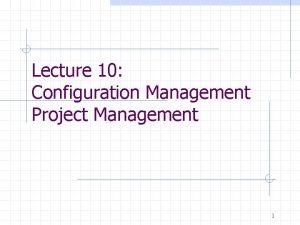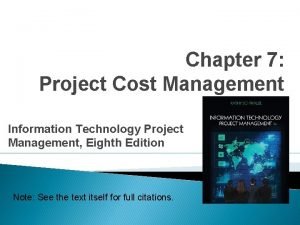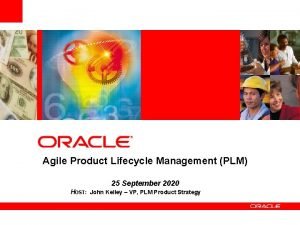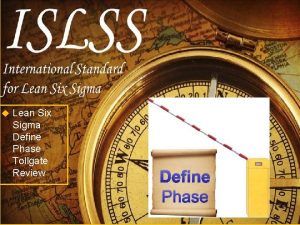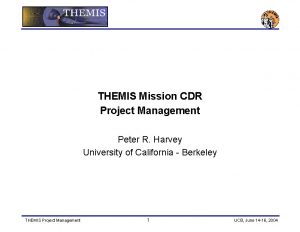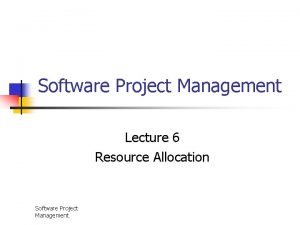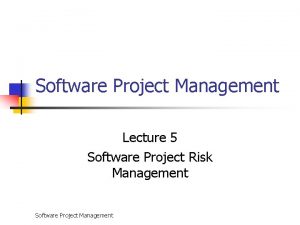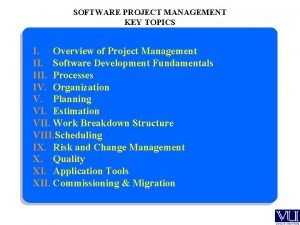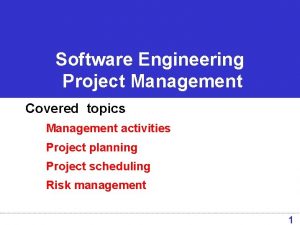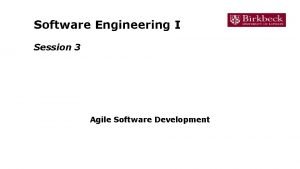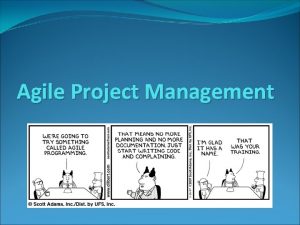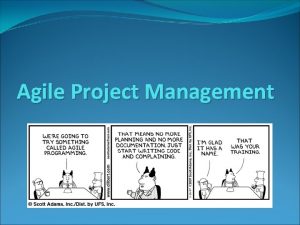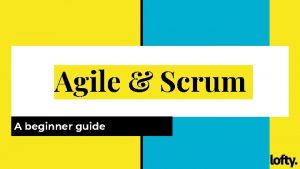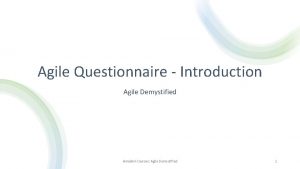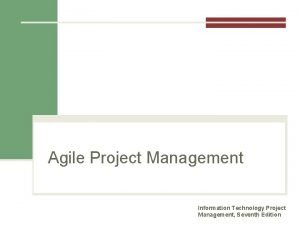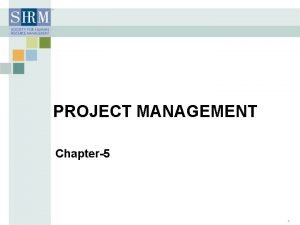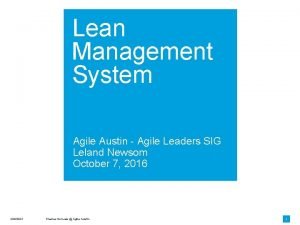Agile Project Management What Is Agile Agile is

















































- Slides: 49

Agile Project Management

What Is Agile? �Agile is a group of software development methodologies �Scrum �Extreme Programming (XP) �Lean �Etc. �Key Characteristics: �Small increments �Adaptive to change �Collaborative © 2012

Defining Agility �Individuals and interactions over processes and tools �Encourage engagement between functional areas �Avoid using documents to hand off information �Working software over comprehensive documentation �Focus on incrementally attacking the problem �Stay releasable © 2012

Defining Agility �Customer collaboration over contract negotiation �Prioritize based on business value �Work together to ensure that value is maximized �Responding to change over following a plan �Plan just enough (no more than necessary) �Defer to the last responsible moment �Stay flexible and leverage what you’ve learned © 2012

Why Do It? �It results in better software �Higher productivity (you get what you need quicker) �Higher quality �More customer satisfaction �More visibility �Better morale © 2012

Roles �Product Owner �Scrum Master �Team Member © 2012

Product Owner �Prioritizes the backlog �Communicates what is important … and what is not �Is a proxy for the customer © 2012

Scrum Master �Responsible for the process �Facilitates agile meetings �Helps to remove road blocks © 2012

Team Member �Signs up for work �Asks questions �Collaborates with others �Communicates progress / blocking issues �Makes it happen © 2012

What Does It Look Like? �Backlog �Release Planning �Iterations (1 -4 weeks long) � Iteration Planning � Daily standup � Demo � Iteration Retrospective �Release Retrospective © 2012

The Backlog �A ranked list of stories �What is a story? �A scenario that we must do work to implement which results in business value �Typically in the form of: “As a <type of user>, I want <feature> so that <business value>” �Good stories meet the INVEST criteria © 2012

Example Post a Job �As a recruiter I want to be able to post a job to the web site so that I can generate interest in the position. © 2012

Why Prioritize? © 2012

Prioritization Doesn’t Stop �The product owner re-prioritizes after each iteration �We’ve learned more about the business �Let’s take advantage of that �The further down the list something is, the less defined it will be and the less important it is to prioritize precisely © 2012

What Does an Iteration Look Like? Daily Stand up Meeting • Done since last meeting • Will do for next meeting • Obstacles 24 hours Iteration Planning Meeting • • Review Product Backlog Define Iteration Goals Estimate Iteration Backlog Commit Iteration Backlog 1 week Backlog tasks expanded by team to 1 month Product Backlog As prioritized by Product Owner Demo Show off what you’ve done Potentially Shippable Product Increment Retrospective Inspect and Adapt Vision and Release Plan © 2012

Iteration Planning �Define scope as a team �Define a clear understanding of “done” �Plan just enough that you can commit © 2012

Before you Start � Well Groomed Product Backlog � Prioritized � Estimated � Iteration Theme/Goal Estimated © 2012 Prioritized

A Typical Iteration Planning Session � Discuss Logistics � Review iteration goals � For each story (in Priority Order): � Understand it � Task it out � Stop when “full” and commit © 2012 Typical Duration: 1 -4 hours Attendees: • Product owner • Scrum master • Delivery team Materials: • Stories (cards or online) • Task planning material (cards, whiteboard, online) • Planning/estimation materials (e. g. planning poker cards)

Discuss Logistics �Review Historical Velocity �Review Team Availability �Holidays / Vacations �Meetings �L 3 Support, outside commitment, etc �Review the Definition of Done © 2012

Review Iteration Goal(s) �At a high level, what are we trying to accomplish this iteration �Examples: �Improve reporting �Improve performance �Get ready for beta © 2012

Understand the Story �Discuss the story �Discuss why it is important �Elaborate on acceptance criteria/tests �Make priority adjustments �Break down as needed © 2012

Task out the Story �Define tasks �Estimate the work involved �Double check ability to commit The Product Owner can help in avoiding less valuable work © 2012

Repeat �Until the team cannot take on more �Split stories as necessary © 2012

Commit �Everyone agrees the iteration is doable �Use disagreement and uneasiness in team members to drive out hidden risks, tasks, and issues �Drive agreement with a fist of five � Absolutely, no question � I think this is good and will make it happen � I can support this � I’m uneasy about this and think we need to talk about it more � Let’s continue discussing this idea in the parking lot © 2012

Managing your Tasks

Daily Standup �What did I do yesterday? �What will I do today? �What’s blocking me? Quick Parking Lot © 2012 High Value For the team

Demo �Show off what you got “done” in the iteration �Should be from the user’s perspective �No slides �No code �Just working software If a customer could attend your demo, you’re doing it right © 2012

Retrospective �Review the process over the last iteration �What went well? �What went poorly? �How can we do things better? �Take the top 1 -3 items and make sure you make progress on them in the next iteration Improve © 2012

Estimating �Identify a medium sized story that is well understood; call it a 5 �Now estimate other stories relative to that �Is it about the same, ½ as difficult, twice as difficult? �Use Fibonacci numbers: 1, 2, 3, 5, 8, 13, 21 �If bigger than that or if too hard to estimate, split the story �Tackle as a team; Planning poker can help (www. planningpoker. com) © 2012

Velocity �Now that stories have sizes, you can track how many points you typically get done in an iteration �Only count points for stories that get accepted in the iteration �You can now use this to predict future completion rates © 2012

Structuring Teams �It is preferable to have each team have the ability to complete its work by itself �In other words, instead of a team per component, have teams with members who have knowledge of each component that will need to change to deliver something © 2012

Divvying Things Up �Your goal is to divvy things up so that teams are working on items of around the same priority If each team able to get 3 blocks in the release, the highlighted stories won’t make it Bad © 2012 By better distributing stories amongst the teams, look which stories won’t make it Good

Dependencies �Approaches (go with the first one you can): �Structure the teams so that a single team can solve the problem end to end �Do the work within the same iteration �Implement the service and then use it �Stub out the service and implement it later �Make sure the dependent teams (including external ones) are represented at release planning © 2012

Release Planning �Kick off / Overview �Break Out Sessions �Review Results © 2012

Release Planning Deliverables �Plan for each Iteration �Assumptions �Dependencies �Risks © 2012

Release Planning Wrap Up �Go through each iteration for each team �Are things synched up across teams? �Are you attacking the most important stories? �Does the team believe in the results? © 2012

After The Meeting �Capture the results in your tool of choice �Update after each iteration © 2012

Anti-Goals of Release Planning is not a commitment! © 2012

Communicating the Future �Themes give you room to be flexible � We know we’re going to do something in this area � We’ll decide as we go how much �If a customer is asking about a particular feature, you can get into a discussion of priorities � Well, that’s important, but we think this and this are more important, what do you think? �Demos are a potential opportunity to get a customer involved �Smaller, incremental releases generate feedback on what to dig into in more detail © 2012

Tracking the Release © 2012

Managing Risk Waterfall Agile �Time, scope and resources “fixed” �Changing one affects the others as well as quality �Manage the plan �Try to minimize change �Time, resources and quality fixed �Changing time or resources affects scope �Manage the priorities �Change as you learn more

Life in an Iteration �Once in an iteration, scope is fixed �Do the work in small increments �Work closely with others �It isn’t done until it is really done �If it doesn’t add value, don’t do it (or minimize) �Leave decisions to the last responsible moment It is a team effort © 2012

Self Organizing Teams �The team members know how they can best contribute �They figure out how to divvy the work up / attack the problem �The scrum master facilitates and is part of the team © 2012

Feedback is key �Do a little �Get feedback �Respond to feedback by doing a little more �Automation helps decrease time to get feedback �Nightly/continuous build �Unit tests �Acceptance tests © 2012

Agile Documentation �Keep to the minimal responsible amount of doc �No more than you need at any point in time �Just enough to understand dependencies and mitigate risks �Do you need this now? �If not, try to reduce or eliminate it �Wiki’s work well for collaborative design © 2012

Management Is Not Enough! �Engineering practices must change �Avoid specialization �Keep design simple and refactor as needed (YAGNI) �Create good automated regression tests �Integrate frequently �Peer review �Consider �Test Driven Development (or Behavior Driven Development) �Pair Programming �Co-location �Dedicated team members © 2012

Staying Releasable �Goal: Could release after any iteration �Reality: Ability to do this will evolve over time �Staying releasable gives you the ability to more easily change direction / take on new things �It also tends to improve quality �And predictability © 2012

Definition of Done �You need to define for your environment �Definition will evolve over time �Example: �Unit tests written and passed �Acceptance tests automated and passed �User facing documentation written �Checked in to the build © 2012

Questions? Walter Bodwell Planigle wbodwell@planigle. com Twitter: @wbodwell www. planigle. com www. walterbodwell. com © 2012
 Agile ms project template
Agile ms project template Introduction to software project management
Introduction to software project management Agile methodologies wiki
Agile methodologies wiki The role of project management in achieving project success
The role of project management in achieving project success Process discriminants in software project management
Process discriminants in software project management Reasons for reducing project duration
Reasons for reducing project duration Introduction to project management kathy schwalbe
Introduction to project management kathy schwalbe What is strategic assessment in software project management
What is strategic assessment in software project management Types of project audit in project management
Types of project audit in project management Types of terminations
Types of terminations Inception in agile
Inception in agile Agile test strategy
Agile test strategy Agile project charter
Agile project charter Canvas de projeto exemplo
Canvas de projeto exemplo Agile project proposal
Agile project proposal Guest2guest
Guest2guest Managing assets vs asset management
Managing assets vs asset management Configuration management in project management
Configuration management in project management Principles of project cost management
Principles of project cost management Configuration management in software project management
Configuration management in software project management Project integration management processes
Project integration management processes Agile product cost management
Agile product cost management Agile management group
Agile management group Cost management in agile projects
Cost management in agile projects Release management
Release management Agile bom management
Agile bom management Agile incident management
Agile incident management Scientific management
Scientific management Top management middle management first line management
Top management middle management first line management Top level management
Top level management Background of the project proposal
Background of the project proposal Project indicator enables a software project manager to
Project indicator enables a software project manager to Theoretical framework in research
Theoretical framework in research Cmmi requirements management
Cmmi requirements management Project procurement management lecture notes
Project procurement management lecture notes Vehicle management system login
Vehicle management system login Gstm university of pretoria
Gstm university of pretoria Tollgate process
Tollgate process Pdr cdr project management
Pdr cdr project management Pdr cdr project management
Pdr cdr project management The management spectrum (3 p’s) are
The management spectrum (3 p’s) are Telecom risk management
Telecom risk management Hospital management system proposal
Hospital management system proposal Strategic assessment in software project management
Strategic assessment in software project management Resource requirements example
Resource requirements example Software project risk
Software project risk Software project management topics
Software project management topics Software management activities
Software management activities Crystal method project management
Crystal method project management Csi in project management
Csi in project management











